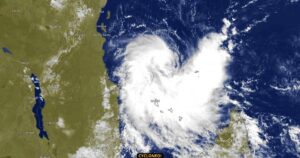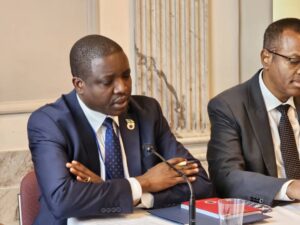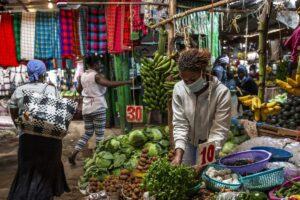- Kenya, Tanzania braces for torrential floods as Cyclone Hidaya approaches
- EAC monetary affairs committee to discuss single currency progress in Juba talks
- Transport and food prices drive down Kenya’s inflation to 5% in April
- Payment for ransomware attacks increase by 500 per cent in one year
- History beckons as push for Kenya’s President Ruto to address US Congress gathers pace
- IMF’s Sub-Saharan Africa economic forecast shows 1.2 percent GDP growth
- The US Congress proposes extending Agoa to 2041, covering all African countries
- Millions at risk of famine as fuel tax row halts UN aid operations in South Sudan
Author: Padili Mikomangwa
Padili Mikomangwa is an environmentalist based in Tanzania. . He is passionate about helping communities be aware of critical issues cutting across, environmental economics and natural resources management. He holds a bachelors degree in Geography and Environmental Studies from University of Dar es Salaam, Tanzania.
The banking sector in Tanzania has been experiencing a rather significant shift over the past few years.
According to the Bank of Tanzania (BoT) records, 40 registered banks operate in Tanzania, National Microfinance Bank (NMB) inclusively—which is now making a substantial investment in offering seamless banking services across Tanzania.
NMB Bank is one of the biggest banks in Tanzania, with over 13 years of operations in Tanzania. The bank’s ownership is split between the government via the Ministry of Finance, holding 31.8 per cent of the shares, public shareholders taking 21.6 per cent of shares of NMB, with foreign investors taking 3.3 per cent (directly or nominees)
Earlier in October, NMB Bank ushered a newly re-branded mobile platform and its app “Mobile Klik” to improve seamless access to financial services in Tanzania.
NMB Bank serves as robust retail and commercial bank, offering financial services to over 3.5 million customers served …
Tanzania Investment Centre (TIC) highlights that the East African fastest growing economy (at 7 per cent rate) keeps soaring as it has seized the golden opportunity to attract viable investments across energy, industrial, construction and services sectors.
With the Gross Domestic Product (GDP) growth at 6.6 per cent, investment in Tanzania remains to be the top-selling point.
On October 28, TIC presented rather crucial numbers to the members of the press, showcasing various strides made by the most vital, development parastatal in the country.
According to TIC, over the past 9 months, —227 investment projects have been registered worth over $ 1.7 million.
Further, the projects register fell under the—industrial sector which is anticipated to attract almost 38,836 jobs for Tanzania.
In that context, Bank of Tanzania (BoT), quarterly report (June 2019) indicated that construction, agriculture and transport and storage were among, the top contributors to economic growth.
On the …
Tanzania is one of Southern Africa Development Community (SADC) member states with strategic port spheres, that stand to prove billions, under strategic import and export situations.
Bank of Tanzania (BoT), indicates East Africa’s growing economy, Gross Domestic Product (GDP) stands at 6.6 per cent, while construction, transport activities and agriculture (raw material producer) account for 65.1 per cent of the output growth.
An array of materials gets shipped off Tanzania which include minerals—gold and agricultural products such as cashew nuts, coconut, sisal, coffee, and raw cotton.
On the same note, BoT September economic review, paints a rather promising perspective commenting that: exports of goods and services amounted to $921.8 million in August 2019 compared with $ 714.8 million in the preceding month, of which export of goods increased to $ 635.1 million from USD 408.9 million.
Additionally, traditional goods exports (unprocessed minerals and agriculture-products) stood at $44.4 million compared with …
Tanzania’s ambition of being East Africa’s one-stop hub for commerce and tourism via aviation is taking shape.
Air Tanzania Company Limited (ATCL) new Boeing 787-7 Dreamliner, touched down in Tanzania on Saturday, October 26, as reported by The Citizen. The impressive aircraft has a capacity of 300 passengers.
This purchase is the latest in a series of strategic actions taken by the government, including—acquiring 4 radar systems worth $29.2 million to secure its airspace and enhance the aviation industry performance, which has proven to be rather vital to the economy.
Further, Tanzania launched it’s modernized airport-terminal (3) at Julius Nyerere International Airport, which will serve up to 8 million passengers per year, it was built at a cost of over $314 million.
Air Tanzania Company Limited (ATCL) oversees over 10 aircrafts in its fleet including Bombardier Q400 and Airbus A220-30, this according to Ministry for Works, Transport and Communications. The …
The large-scale mining industry in Tanzania just got interesting.
On October 20th, the government of Tanzania and the mining companies previously managed by Acacia Mining, but now managed by Barrick Gold Corporation, strike a new partnership, to settle all disputes, which saw major reforms in the sub-sector in the past 3 years.
According to the government of Tanzania, the agreements have been submitted to the Tanzanian attorney general for review and legalization.
The new partnership comes, after—Acacia (now Barrick Gold), Tanzania’s largest gold producer was cleared by the Magufuli government and resumed its metal concentrates exportation after a series of regulations led by The Mining Commission of Tanzania Ministry of Minerals that impeded the export of the mineral.
Further, according to Barrick Gold, the terms of the agreement include payment of $300 million to settle all outstanding tax and other disputes; the lifting of the concentrate export ban; the sharing …
Tanzania’s smartphone’s network—Airtel Tanzania, has ushered a new mobile money service branded “Send With a withdraw fee”, emerging with a rather customized competitive advantage within the growing mobile money industry in Tanzania.
According to Tanzania Communications Authority (TCRA) June quarterly statistics, there are over 22.9 million mobile money accounts in Tanzania, responsible for around 260 million mobile money transactions.
Further, TCRA report shows that, there are over 43 million telcom subscribers, while Airtel Tanzania owns 26 per cent of the market share (over 11 million subscribers) and 18 per cent of the mobile money share.
The service which was launched on October 16, will enable Airtel Money customers in Tanzania, to send money to their counterparts differently compared to other networks, this time—all transactions will be executed with a built-in calculated sending fee, unequivocally offering a seamless service necessary for a mobile money take over, as elaborated by …
Sustainable development can’t be realized in Tanzania without a healthy population, that’s why the health sector has acquired a rather vital financial support from its development partner Germany to ameliorate, Information and Communications Technology (ICT) within the National Health Insurance Fund (NHIF) parameters.
According to a report by The Citizen, the grant was signed on 16th October, at Ministry of Finance’s premises in commercial city—Dar es Salaam, witnessed by ministry’s Permanent Secretary, Dotto James and Acting Germany Ambassador Jorg Herrera.
The grant comes at the time when insurance services are slated for adoption by the insurance industry in Tanzania. Per ministry of health records, more than 2 million households have been reached by the Tanzanian Community Health Fund (CHF), and more than 12.5 million beneficiaries, equivalent to 25 percent of the entire population in Tanzania.
READ: Tanzania focus on maternal health bears fruits as mortality drops
Patently, the grant …
The health sector in Tanzania holds a very crucial position in the welfare of the fast-growing economy in East Africa, but also, it requires robust improvements to serve millions of people seamlessly.
That is why, the 2019 Health Supply Chain Summit, taking place in commercial pulse—Dar es Salaam (from 15th to 17th of October), casts to the front, important discussions pertaining health sector’s essential development, including, creation of a health data system for effective control and supply of medicine and medical equipment over space and time.
The Tanzania Health Supply Chain Summit (THSCS) provides an opportunity for various supply chain key players to convene and share lessons learned, successes, challenges and best practices to improve health commodities supply chains in Tanzania.
The summit serves as a platform to positively influence practices and behaviors among government supply chain actors and stakeholders.
In that context, Tanzania’s Ministry of Health, expressed …
Livestock keeping is profitable in Tanzania, especially now, when livestock rearing gathers viable potential amidst growing meat, skin and diary demands.
The sub-sector undoubtedly generates millions to serious investors, but it stands to generate billions to the entire nation, under ameliorated sectorial strategies.
On March 10, 2019, Tanzania brought to life, the Livestock Master Plan (TLMP) which allocated over $ 608 million in its realization, 64 per cent of the funding is foreseen to be fetched from the private sector and 36 per cent originating from government funding.
The TLMP is a five-year plan strictly set up to address major challenges facing the sector and transform via guiding viable investments in major profitable subsectors.
In realization of the grand plan, the government of Tanzania requested: the International Livestock Research Institute (ILRI) provided technical assistance and training to the Tanzania Ministry of Livestock and Fisheries in a project funded by …
The government of Tanzania, has carefully laid out its plans to boost the mining sector in the country.
The country is now adopting robust measures, within legal and operational lines to ensure the country gets optimum benefits from this. It has also announced plans to set up trading centers are established as well as spruce up value addition efforts.
Since Tanzania’s President John Magufuli came to power, various strategic sectors have been under heavy scrutiny and vital changes, necessary for a robust Tanzanian success story, primarily the minerals sector—a rather high-earning sector in Tanzania.
From the Acacia Mining saga to local securing sustainable small miners’ welfare, the government has immensely waged its efforts to improve mining operations and minerals trading in Tanzania, including: the erection of the Mererani wall (3 meters high, 24.5 kilometers long and worth over $2.6 million) and establishment of minerals trading centers across the country.
The …




